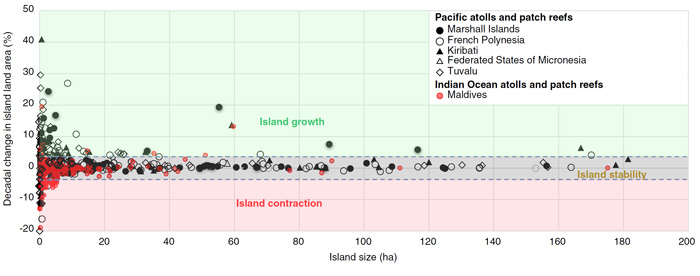| Tweet | Follow @co2science |
Paper Reviewed
Duvat, V.K.E. 2019. A global assessment of atoll island platform changes over the past decades. WIREs Climate Change 10: e557.
Over the past few years, multiple research teams have examined the vulnerability of atoll islands to sea level rise, including Duvat et al. (2017), Duvat and Pillet (2017), Purkis et al. (2016), Testut et al. (2016), Ford and Kench (2016), Ford and Kench (2015), Kench et al. (2015), Biribo and Woodroffe (2013), Ford (2013), Rankey (2011), Dunne et al. (2012), Ford (2012) and Webb and Kench (2010). The latest to do so is Duvat (2019), who conducted a review of the existing literature to compile the largest single database assessing atoll island stability. And what did the new review reveal?
In all, 35 atolls and 852 islands were examined in the study, allowing for a quantitative analysis of land area change for a subset of 30 atolls and 709 islands. That analysis revealed a global trend of island land area persistence. More specifically, Duvat reports that "29 atolls exhibited a stable land area, while one (South Tarawa, Kiribati) increased in size." Of the 709 islands in these 30 atolls, 518 (73.1%) were stable, 110 (15.5%) increased in size, and 81 (11.4%) decreased in area. Thus, a total of 88.6% of all islands examined were either stable or increased in size.
Other key information presented by Duvat was the finding that island behavior correlates with island size. In this regard, the author reports that the smallest islands (< 5 ha) exhibited the highest variability in land area change. Larger islands were more stable (see Figure 1), as Duvat notes that "all of the islands larger than 10 ha experienced either stability (209/234 islands, that is, 89.32%) or expansion (25/234 islands, that is, 10.68%)." For islands under 10 ha in size, 65% experienced stability (no change), 17.9% expanded and 17.1% contracted.
In concluding her review, Duvat writes that her work "confirms that over the past decades to century, atoll islands exhibited no widespread sign of physical destabilization by sea-level rise," adding that, "importantly, islands located in ocean regions affected by rapid sea-level rise showed neither contraction nor marked shoreline retreat." Taken together, therefore, it seems obvious that model-based predictions of rapidly rising sea levels due to anthropogenic global warming are not presently having, nor will they likely have in the future, any negative impact on atoll island stability.

Figure 1. Decadal change in island land area for 709 Pacific and Indian Ocean islands. Source: Duvat (2019).
References
Biribo, N. and Woodroffe, C.D. 2013. Historical area and shoreline change of reef islands around Tarawa Atoll, Kiribati. Sustainability Science 8: 345-362.
Dunne, R.P., Barbosa, S.M. and Woodworth, P.L. 2012. Contemporary sea level in the Chagos Archipelago, central Indian Ocean. Global and Planetary Change 82-83: 25-37.
Duvat, V.K.E. and Pillet, V. 2017. Shoreline changes in reef islands of the Central Pacific: Takapoto Atoll, Norther Tuamotu, French Polynesia. Geomorphology 282: 96-118.
Duvat, V.K.E., Salvar, B. and Salmon, C. 2017. Drivers of shoreline change in atoll reef islands of the Tuamotu Archipelago, French Polynesia. Global and Planetary Change 158: 134-154.
Ford, M. 2012. Shoreline changes on an urban atoll in the central Pacific Ocean: Majuro Atoll, Marshall Islands. Journal of Coastal Research 28: 11-22.
Ford, M. 2013. Shoreline changes interpreted from multi-temporal aerial photographs and high resolution satellite images: Wotje Atoll, Marshall Islands. Remote Sensing of Environment 135: 130-140.
Ford, M.R. and Kench, P.S. 2015. Multi-decadal shoreline changes in response to sea level rise in the Marshall Islands. Anthropocene 11: 14-24.
Ford, M.R. and Kench, P.S. 2016. Spatiotemporal variability of typhoon impacts and relaxation intervals on Jaluit Atoll, Marshall Islands. Geology 44: 159-162.
Kench, P.S., Thompson, D., Ford, M.R., Ogawa, H. and McLean, R.F. 2015. Coral islands defy sea-level rise over the past century: Records from a central Pacific atoll. Geology 43: 515-518.
Purkis, S.J., Gardiner, R., Johnston, M.W. and Sheppard, C.R.C. 2016. A half-century of coastline change in Diego Garcia - The largest atoll island in the Chagos. Geomorphology 261: 282-298.
Rankey, E.C. 2011. Nature and stability of atoll island shorelines: Gilbert Island chain, Kiribaati, Equatorial Pacific. Sedimentology 58: 1831-1859.
Testut, L., Duvat, V., Ballu, V., Fernandes, R.M.S., Pouget, F., Salmon, C. and Dyment, J. 2016. Shoreline changes in a rising sea level context: The example of Grande Glorieuse, Scattered Islands, Western Indian Ocean. Acta Oecologica 72: 110-119.
Webb, A.P. and Kench, P.S. 2010. The dynamic response of reef islands to sea-level rise: Evidence from multi-decadal analysis of island change in the Central Pacific. Global and Planetary Change 72: 234-246.
Posted 15 February 2019



